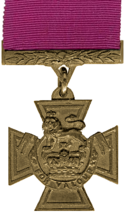James Marshall (VC)
James Neville Marshall VC MC* | |
|---|---|
 | |
| Born | 12 June 1887 Manchester, Lancashire |
| Died | 4 November 1918 (aged 31) Sambre–Oise Canal, France |
| Buried | Ors Communal Cemetery |
| Allegiance | |
| Service | |
| Years of service | 1914–1918 |
| Rank | Acting Lieutenant colonel |
| Unit | Irish Guards |
| Commands | 16th (Service) Battalion, Lancashire Fusiliers |
| Battles / wars | World War I † |
| Awards |
|
| Spouse(s) |
Edith Maud Taylor (m. 1911) |
Lieutenant Colonel James Neville Marshall VC, MC & Bar (12 June 1887 – 4 November 1918), was an English recipient of the Victoria Cross, the highest and most prestigious award for gallantry in the face of the enemy that can be awarded to British and Commonwealth forces.[1]
Military career
[edit]Marshall was born in Manchester in June 1887. His family moved to Oxford Road, Acocks Green, Birmingham in around 1894, his father being a draper. James Neville went to King Edwards School and after leaving worked at the Birmingham and Midland Institute and in the Medical Faculty of the University of Birmingham in a clerical capacity. He studied veterinary practice, then worked in this field in Harlow, Essex. Marshall married Edith Maud Taylor, daughter of successful maltster Mr. Henry Algernon Taylor on 20 September 1911.[2] He started off the First World War in Argentina, buying horses but then enlisted in the Irish Guards.[3]
He was 31 years old, and an acting lieutenant colonel in the Irish Guards, British Army, attached to the Lancashire Fusiliers, commanding 16th Battalion during the First World War at the battle of Sambre when the events took place for which he was awarded the VC.
On 4 November 1918 at the Sambre–Oise Canal, near Catillon, France, when a partly constructed bridge was badly damaged before the advanced troops of his battalion could cross, Marshall organised repair parties. The first party were soon killed or wounded, but the colonel's personal example was such that more volunteers were instantly forthcoming. Under intense fire and with complete disregard of his own safety, he stood on the bank encouraging his men and helping in the work. When the bridge was repaired he attempted to lead his men across, but was killed in the attack.[4][5] Wilfred Owen was killed in the same engagement soon after the bridge was crossed as he encouraged his men.
He was also awarded the Croix de Guerre (Belgium) and was made a Chevalier of the Order of Leopold (Belgium). His Victoria Cross is displayed at The Guards Regimental Headquarters (Irish Guards RHQ), London, England.

Marshall is commemorated at Harlow War Memorial Institute and on their website.[6]
Marshall is also commemorated in the Old Harlow Baptist Church, St Mary's (Churchgate Street) and St Mary-at-Latton churches on their memorials to the fallen of Harlow.[3]
James Marshall is also mentioned several times in Pat Barker's Booker Prize-winning novel The Ghost Road, in which he is referred to as 'Colonel Marshall-of-the-Ten-Wounds'.[7]
References
[edit]- ^ Gliddon 2014, pp. 258–262.
- ^ "Lt Col. James Neville Marshall". hwmi. Retrieved 13 July 2019.
- ^ a b "Our impact" (PDF). Birmingham University.
- ^ "No. 31178". The London Gazette. 11 February 1919. pp. 2249–2250.
- ^ CWGC entry
- ^ Memorial Section Harlow War Memorial Institute
- ^ "The Ghost Road Characters". GradeSaver. 6 April 2017. Retrieved 11 March 2020.
External links
[edit]- James Marshall at Find a Grave
- Gliddon, Gerald (2014) [2000]. The Final Days 1918. VCs of the First World War. The History Press. ISBN 978-0-7509-5368-9.
- Lees, Peter (2023). A Hero for All Times: Marshall VC in the Great War. Pen and Sword Books. ISBN 978-1399035323.
- 1887 births
- 1918 deaths
- Military personnel from Birmingham, West Midlands
- Military personnel from Manchester
- Irish Guards officers
- British military personnel killed in World War I
- British Army personnel of World War I
- British Army recipients of the Victoria Cross
- British World War I recipients of the Victoria Cross
- Recipients of the Military Cross
- British recipients of the Croix de guerre (Belgium)
- People educated at King Edward's School, Birmingham
